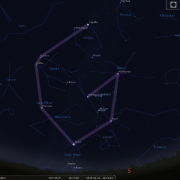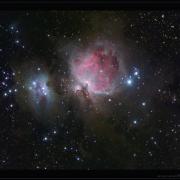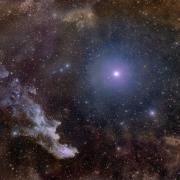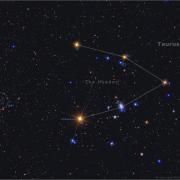In this month's In-Focus article, Mark Dawson takes a tour of the "Heavenly G", which links bright stars in the southern winter sky.
Stellar evolution is regarded as one of the fundamental processes involved in the building of the universe we see around us today. Just as someone who studies the variety and growth of trees in a forest to fathom its evolutionary cycle, so astronomers study the forest of stars in the night sky to understand stellar cycles and the implication these have on the wider universe.
Nowhere is the life story of a star better followed than in the region bounded by the glittering array of bright luminaries sometimes referred to as the Celestial or Heavenly G, which encompasses much of the southern aspect of the winter sky. This huge asterism spans six constellations and resembles the outline of a capital G, slightly distorted and tilted. The eight bright stars that form the ‘G’ start with Aldeberan, then track up to Capella in Auriga before passing through Castor and Pollux in Gemini en route to Procyon and Sirius in the lesser and greater dogs. From Sirius the next leg takes in Rigel, before making the final dash to Betelguese in Orion.
Embedded within our snapshot of stellar life, below the belt stars of Orion, lies the Orion nebula, a stellar nursery 1250 light years distant. It is only visible because of the group of very young, hot, massive stars collectively known as the ‘Trapezium’ are illuminating it from within. Intense radiation from these stars has opened up great voids in the surrounding gas and dust clouds. Many less massive stars are also forming, cocooned in dense knots of the hydrogen gas.
The Hubble Space Telescope has uncovered over a hundred of these protostars similar in mass to our Sun. Over time stars that form in such clusters will disperse completely. The lovely open cluster in Taurus known as the Pleiades or Seven Sisters is a fine example of an open cluster, estimated to be no more than 100 million years old.
To continue our analogy with a forest of trees, stars also evolve into different types and grow to differing sizes. The chief factor in determining the paths taken come down to the initial amount of gas (and some dust) the star is formed from. Huge quantities of hydrogen gas and dust are required to make a star. Our galaxy (like many spiral galaxies) has an abundance of such material which forms in clouds tens or even hundreds of light years in size. The Orion nebula is part of one such cloud. The initial mass from a collapsing gas cloud determines the evolutionary path of a star and hence its ultimate fate. The greater the quantity of hydrogen gas being compressed and heated, the more massive a star may become, but the shorter its lifespan will be, using its fuel at a much faster rate. Take a look at blue/white Rigel in our ‘G’ for example. This brilliant star marking Orion’s foot lies around 1000 light years away but is still ranked seventh in the night sky. Rigel is young, hot and exceedingly massive, around 70,000 times more luminous than our sun. It is converting hydrogen – (its main fuel source –like all stars) at such a prodigious rate, its days are already numbered and it will shine for a few hundred million years only.
Other ‘younger’ stars on the celestial ‘G’, include Sirius, brightest star in the night sky. A mere 26 times more luminous than the Sun, Sirius is a white main sequence star with a surface temperature of around 10,000 degrees Centigrade, double that of our Sun, but only half that of Rigel. The reason Sirius appears so bright in the night sky is its proximity – just 8.6 light years distant. Sirius has a tiny companion star in attendance – a white dwarf star (known as the Pup) 24,000 miles in diameter, the degenerate core of a solar mass sized star. As to why it is so close to the Dog Star remains a bit of a mystery.
Slightly cooler than Sirius, at around 7,500 C, Procyon in Canis Minor is only seven times more luminous than our sun and situated 11.7 light years away. Like Sirius, Procyon also travels through space with a tiny companion white dwarf star. Another ‘G’ member, Castor, the northern twin of Gemini, is also of similar spectral type to Sirius (hot and white) However ‘Castor’ is really a complex sextuplet, six stars;- three sets of doubles all gravitationally bound together and located at a distance of 46 light years. Only the two main components can be separated using a modest scope.
One star of the ‘G’ that may be considered a larger version of our own sun is Capella, located high overhead in the constellation of Auriga. Although appearing as a solitary star, Capella actually consists of two stars; a binary system approximately 43 light years away. The two components are separated by just 70 million miles and can only be split in the largest of scopes. Both components are somewhat bigger, slightly more luminous, but of similar surface temperature. Like our Sun they have reached stable middle age.
Gemini’s other ‘twin’ star, Pollux resides around 36 light years distant. It is further down the evolutionary path, but still regarded as being on the main sequence. Being a little more massive it is converting fuel at a slightly faster rate than our sun. Physically larger, Pollux has a cooler surface temperature as it begins to expand, a fact borne out by the deep amber hue it exhibits when viewed with optical aid and in comparison to Castor, its twin.
Ageing stars nearing the final stages of their lives appear orange in colour. Undergoing a series of internal physical changes, the eventual fate of the remaining two stars of the celestial ‘G is however very different. Aldebaran, appears to be the brightest member of the “V” shaped Hyades open cluster marking the bull’s head, but it lies at half the distance of the genuine cluster members which are 120 light years away. This ‘fiery eye’ has swelled to become a giant star some 35 million miles in diameter. Its eventual demise will be relatively gentle, ‘coughing’ into space most of its bulk, the outer layers becoming intricate bubbles and rings. Along with the vast majority of stars of a similar initial mass to our Sun, Aldebaran will end its days as a planetary nebulae, at the heart of which feebly shine the star’s exposed and extremely dense core, known as a White Dwarf, perhaps 20-30 thousands of miles in diameter.
The most conspicuous orange star of the ‘G’ asterism is Betelguese marking Orion’s shoulder. This red supergiant is so large (and relatively close) its disk has actually been imaged by the Hubble Space Telescope, estimated to be around 500 million miles in diameter at maximum. Betelgeuse constantly readjusts its internal structure to maintain stability, expanding and contracting, thus appearing slightly variable in brightness. One day (hopefully soon - 10000yrs) the fuel supply at the core will be exhausted and nuclear reactions will shut down, ending the force of radiation outwards. With equilibrium lost, the force of gravity will take charge and the outer layers of Betelgeuse will start to collapse onto the core, being hit as they do so by a wave of neutrinos going the other way and causing detonation – Bang. Then, for perhaps 8 weeks Betelgeuse will rival the moon in brightness, before finally fading into obscurity, leaving behind an expanding nebulous maelstrom of gas and a tiny super dense core perhaps 20 miles across known as a neutron star.
If you have access to a telescope, evidence of one such cataclysmic event may be glimpsed in the constellation of Taurus, just above zeta tauri, the star marking the southern horn. Noted by Chinese astronomers as a brilliant ‘guest star’, this supernova blazed forth in 1054 rivalling the quarter phase moon for several weeks. The remnant is known today as the Crab nebula (M1). Viewed through a typical backyard scope the nebula appears as a faint milky stain, but large scopes reveal the expanding and intricate shock waves racing outwards into space and away from its rotating neutron core, a pulsar. Should the shockwaves encounter a region of dense interstellar cloud; like the Orion cloud, a wave of new stellar formation may commence, setting in motion a new stellar cycle. This then is the legacy, the final parting gift, of massive stars, seeding space with the elements necessary for life to arise, and given the breaks, for complex life to potentially thrive. The evidence is overwhelming and compelling, whether it’s the calcium in your bones, the iron in your blood, or even the gold or silver band around your finger, just like you and me it’s all star stuff!
- Log in to post comments








